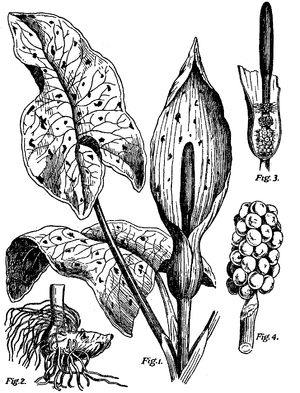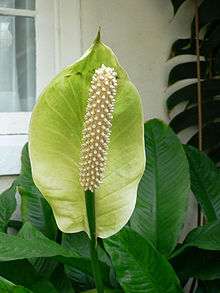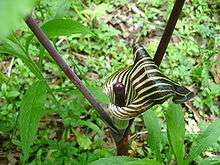Spadix (botany)


In botany, a spadix (/ˈspeɪdɪks/ SPAY-diks; plural spadices /ˈspeɪdɪsiːz/ SPAY-dih-seez, /speɪˈdaɪsiːz/ spay-DY-seez) is a type of spike inflorescence having small flowers borne on a fleshy stem. Spadices are typical of the family Araceae, the arums or aroids. The spadix is typically surrounded by a leaf-like curved bract known as a spathe. For example, the "flower" of the well known Anthurium spp. is a typical spadix with a large colorful spathe.[1]
Monoecious aroids have unisexual male and female flowers on the same individual and the spadix is usually organized with female flowers towards the bottom and male flowers towards the top. Typically, the stigmas are no longer receptive when pollen is released which prevents self-fertilization. We also have Compound Spadix Inflorescence in which the axis is branched. Usually whole Inflorescence is covered by a stiff boat shaped path for example- Coconut.
Gallery
 Elephant ear or ape flower (Xanthosoma sagittifolium) with a white spadix partially surrounded by a green-, rose-, and cream-colored spathe
Elephant ear or ape flower (Xanthosoma sagittifolium) with a white spadix partially surrounded by a green-, rose-, and cream-colored spathe
 Spadix of Spathiphyllum floribundum
Spadix of Spathiphyllum floribundum Titan arum (Amorphophallus titanum) spadix at the United States Botanic Garden
Titan arum (Amorphophallus titanum) spadix at the United States Botanic Garden- Flamingo Lily (Anthurium andraeanum) at the United States Botanic Garden

- Spadix of Spathiphyllum in Brazil.
 Spadix of Typha latifolia
Spadix of Typha latifolia Spadix of Zantedeschia elliottiana cultivar showing male flowers above with pollen and female below
Spadix of Zantedeschia elliottiana cultivar showing male flowers above with pollen and female below